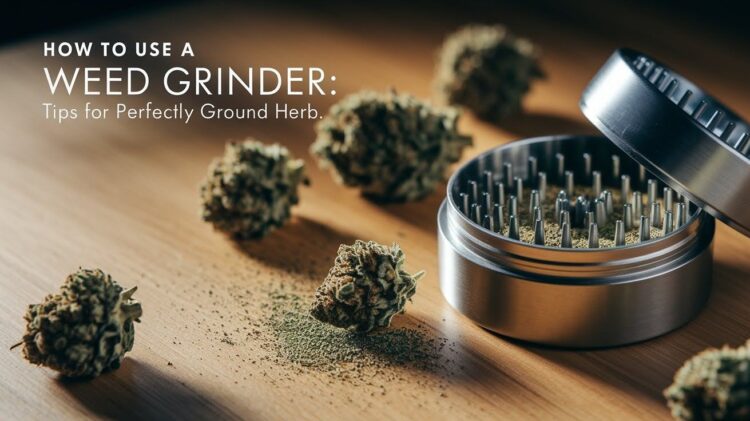If you’re still breaking up your weed by hand, you’re missing out on a better experience. I spent my first two years as a cannabis user fumbling with sticky fingers and uneven burns before someone showed me how to properly use a grinder.
A cannabis grinder is a simple tool that breaks down buds into smaller, consistent pieces. It’s become essential paraphernalia for regular consumers who want smoother smoke and better flavor.
This guide will teach you everything about using weed grinders effectively. You’ll learn what grinders are, why grinding matters, and how to choose the right one for your needs.
After testing dozens of grinders over five years, I can tell you the investment pays off immediately. Ground cannabis burns more evenly, preserves potency, and makes rolling joints much easier.
By the end, you’ll know exactly how to grind your weed for optimal results. No more harsh hits or wasted product from poor preparation.
All information is for legal cannabis consumption only.
Benefits of Using a Cannabis Grinder
Ground weed burns evenly and smoothly, releasing better flavors and eliminating the harsh, uneven hits you get from whole buds.
Enhanced Smoking Experience

Grinding your weed transforms how it smokes. I noticed the difference immediately after my first properly grounded bowl. The harshness, I thought, was normal? Gone.
More evenly ground product burns smoothly and evenly. No more hot spots or uneven burning that ruins your session. Ground cannabis creates consistent airflow through your joint or bowl.
Whole buds have irregular shapes that affect how smoke flows. Some areas burn too fast, while others barely light. This creates harsh, unpredictable hits that waste your weed.
Ground weed smokes cleanly with predictable results. Every hit feels the same. No surprises or coughing fits from uneven burning.
But here’s where it gets interesting.
Smoking or vaping ground weed brings out natural terpene flavors. The grinding process breaks open more surface area. This releases the compounds that create taste and smell.
I remember opening my grinder for the first time after grinding some Blue Dream. The overwhelming natural strain of odors hit me instantly.
Improved taste and flavor enhance your overall smoking experience. You’ll taste strain characteristics instead of just harsh smoke.
Practical Advantages

A good grinder solves problems you didn’t know you had. I used to carry loose buds in plastic bags. Big mistake.
Carrying cannabis in a small grinder is convenient. Everything stays contained and protected. No more crumbled weed at the bottom of your pocket.
Metal grinders feature magnetic casings for secure storage. The lid won’t pop off accidentally. Your cannabis stays fresh and doesn’t spill everywhere.
Well-built grinders help manage troublesome odors. The tight seal keeps smells contained. This is huge for discrete transportation.
You’ll be surprised by how much cannabis your grinder can hold. I can fit enough for several sessions in my pocket-sized grinder.
But the real game-changer is efficiency.
Breaking down large amounts of cannabis becomes quick and easy. What used to take me five minutes of hand-picking now takes thirty seconds of grinding.
Grinding maximizes potency by distributing trichomes evenly. Hand-breaking crushes these crystals. Grinding preserves them and spreads them throughout your material.
More surface area means better taste and aroma. Time and effort savings compared to hand-breaking are significant.
Types of Cannabis Grinders
Two-piece grinders are basic and affordable but waste valuable kief since they lack collection chambers, making them good for beginners on a budget.
Two-Piece Single Chamber Grinders
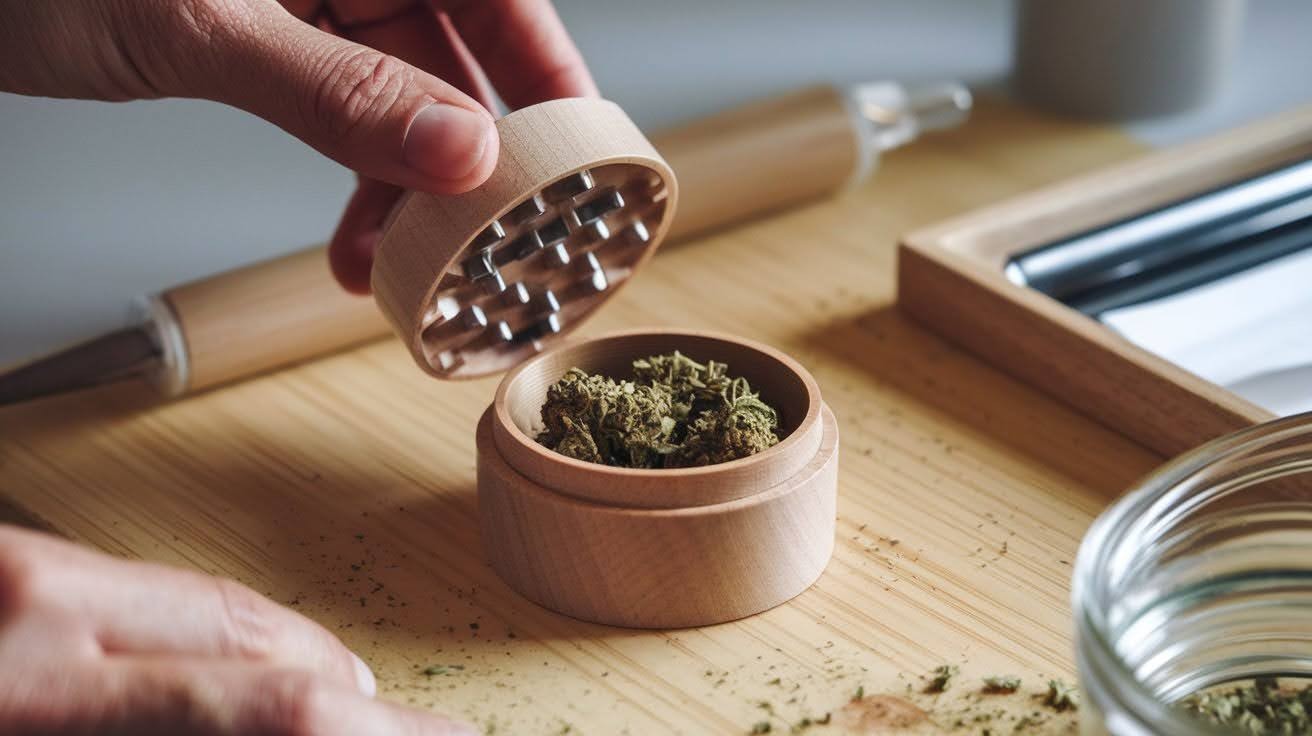
Two-piece grinders are where most people start. I bought my first one at a gas station for $10. It did the job, but barely.
This is the most basic grinder type available. Just two pieces that are close together for single-chamber grinding. Simple concept, simple execution.
Sharp teeth are layered inside each piece. When you twist the halves together, these teeth tear your cannabis apart. No fancy mechanics involved.
Here’s the main limitation: No catch chamber for kief collection. All that precious crystal dust either mixes with your ground bud or sticks to the chamber sides.
You lose valuable kief with every grind. I didn’t realize how much until I upgraded to a four-piece grinder.
The upside? Cheaper price point due to simplicity. You can find decent two-piece grinders for under $20. Perfect for beginners or budget-conscious users.
Material options include wood, plastic, and metal. I’ve tried all three over the years.
Metal versions offer superior durability. My aluminum grinder lasted three years of daily use. The plastic one broke after six months.
Four-Piece Three-Chamber Grinders
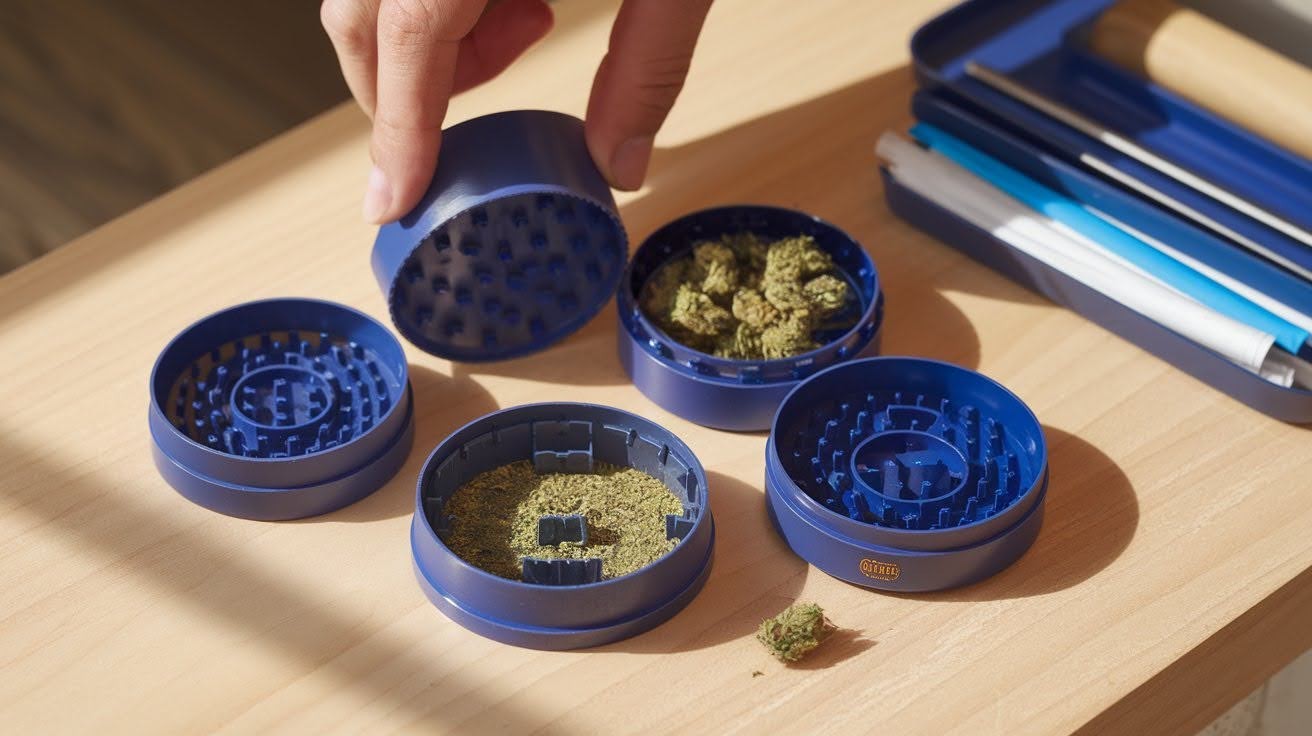
Most regular smokers choose four-piece grinders. They cost more upfront, but the extra functionality pays for itself over time.
These grinders feature three distinct chambers that work together seamlessly. The first chamber grinds your weed with sharp teeth that break it down evenly.
The second chamber collects the ground material in perfect consistency, ready for rolling or packing.
The third chamber is the real game-changer – it catches kief, the finest and most potent crystals that fall through a mesh screen. This crystal catcher makes the extra expenditure worthwhile.
When your stash runs low, you’ve got concentrated goodness waiting. That kief is pure potency you can sprinkle it on bowls or add it to joints.
Most four-piece grinders use durable metal construction, typically aluminum or steel. They handle daily use without breaking down like cheaper alternatives.
The three-chamber system simply works better for regular users who want maximum value from their purchase.
Electric Grinders
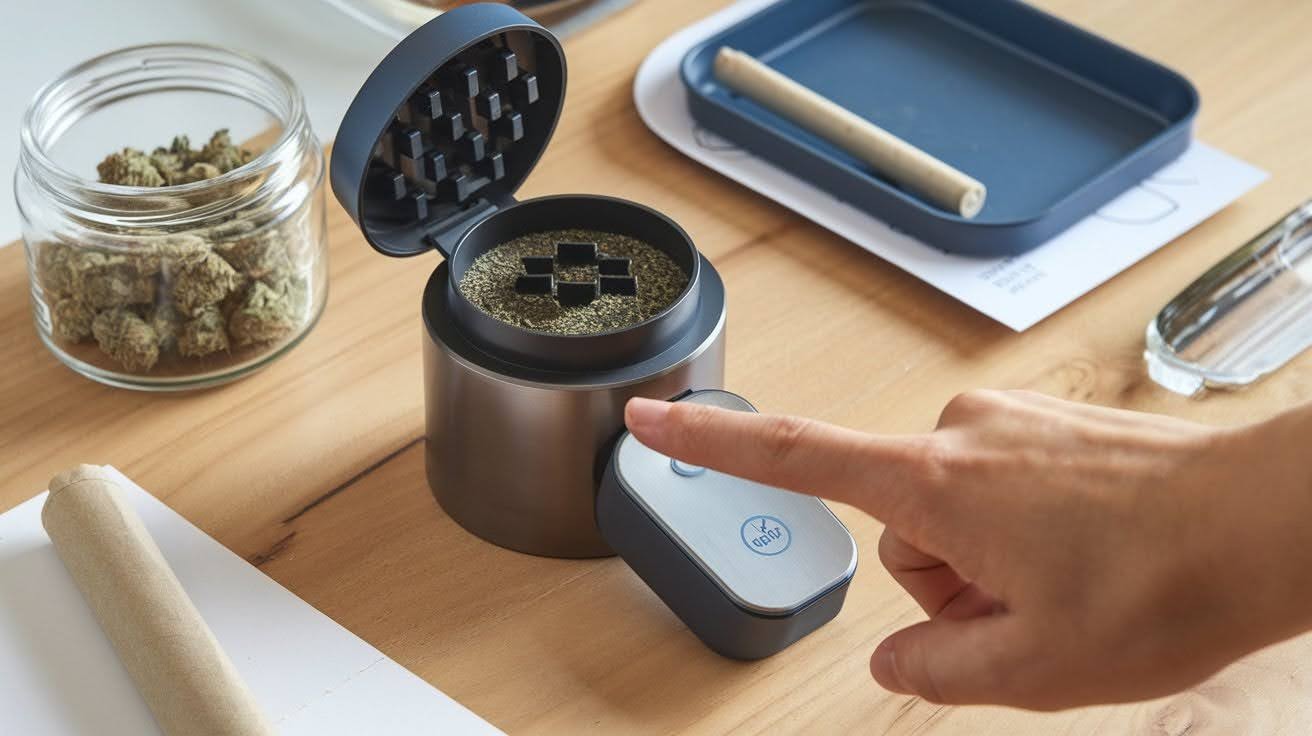
Electric grinders offer ultimate convenience. Push a button and watch your weed get ground automatically.
But here’s the catch – they need power. Either batteries or an outlet connection. No power means no grinding.
The bigger problem? These machines tend to over-process your weed. They don’t just grind it. They pulverize it completely.
That fine powder isn’t ideal for smoking. It burns too fast and can clog your pipes.
Most smokers avoid electric grinders for good reason. The disadvantages outweigh the convenience factor. So, when do they make sense?
If you need to grind large amounts quickly, electric grinders shine. Dispensaries and heavy users sometimes prefer them for bulk processing.
But for regular daily use? Manual grinders work better. You control the consistency. You don’t need batteries. You get better results every time.
The automated process sounds appealing. In reality, most people stick with manual options after trying electric versions. Your weed deserves better than being turned into dust.
Card Grinders

Card grinders are the rare option most people forget about. You probably won’t see them often, but they exist for those who know about them.
Think of a cheese grater, but smaller. One flat piece of metal with holes punched through it. The design is simple – multiple small holes or a fine screen pattern cover the surface.
You rub your weed against its back and forth. Storage is their biggest advantage. They slip into your wallet like a credit card, perfect for travel or discreet carrying.
But here’s the downside – they’re messy to use. Messy. You’ll get weed particles everywhere. Your hands, the table, your clothes. It’s not a clean process like other grinders.
The price makes them appealing, though. These cost almost nothing compared to multi-piece options.
However, functionality is limited. No kief collection. No separate chambers. Just basic grinding action.
Most people try them once and move on to better options that offer cleaner results.
Step-by-Step Guide: How to Use a Weed Grinder
Clean your new grinder with soapy water first, then break buds into small pieces and remove stems before grinding for best results.
1. Preparation Phase
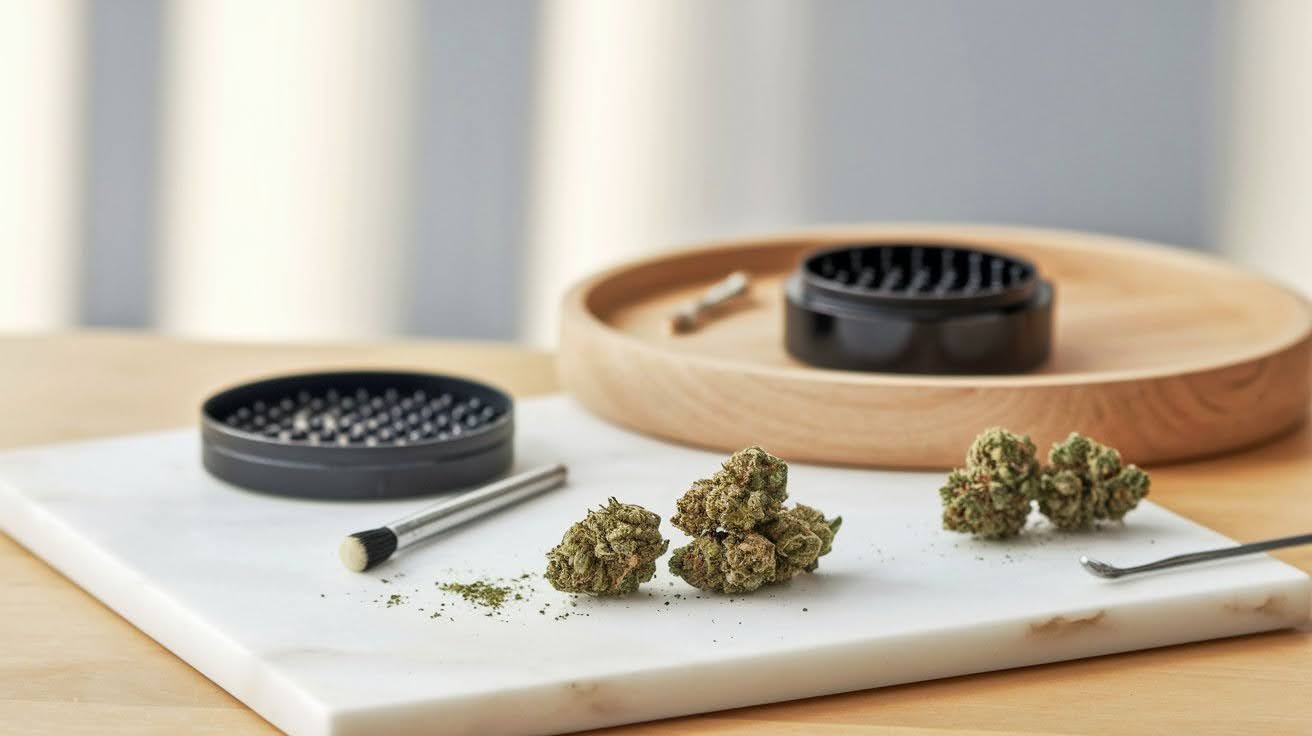
Getting your grinder ready takes just a few minutes. But these steps make a huge difference in your results.
Never use a new grinder straight from the package. Manufacturing residue and debris need to go first. Fill a bowl with warm, soapy water and let the pieces soak for five minutes.
Use a soft brush to scrub each piece thoroughly. An old toothbrush works perfectly. Rinse everything under running water and dry completely.
Don’t stuff whole buds into your grinder. Break them into smaller, manageable pieces first. Remove all stems and seeds – these hard materials can damage your grinder teeth.
Pre-breaking your buds enables more efficient grinding. Your grinder works less, lasts longer, and produces better results. Small pieces grind evenly while large chunks create an inconsistent texture.
Take thirty seconds to prep properly.
2. Loading the Grinder
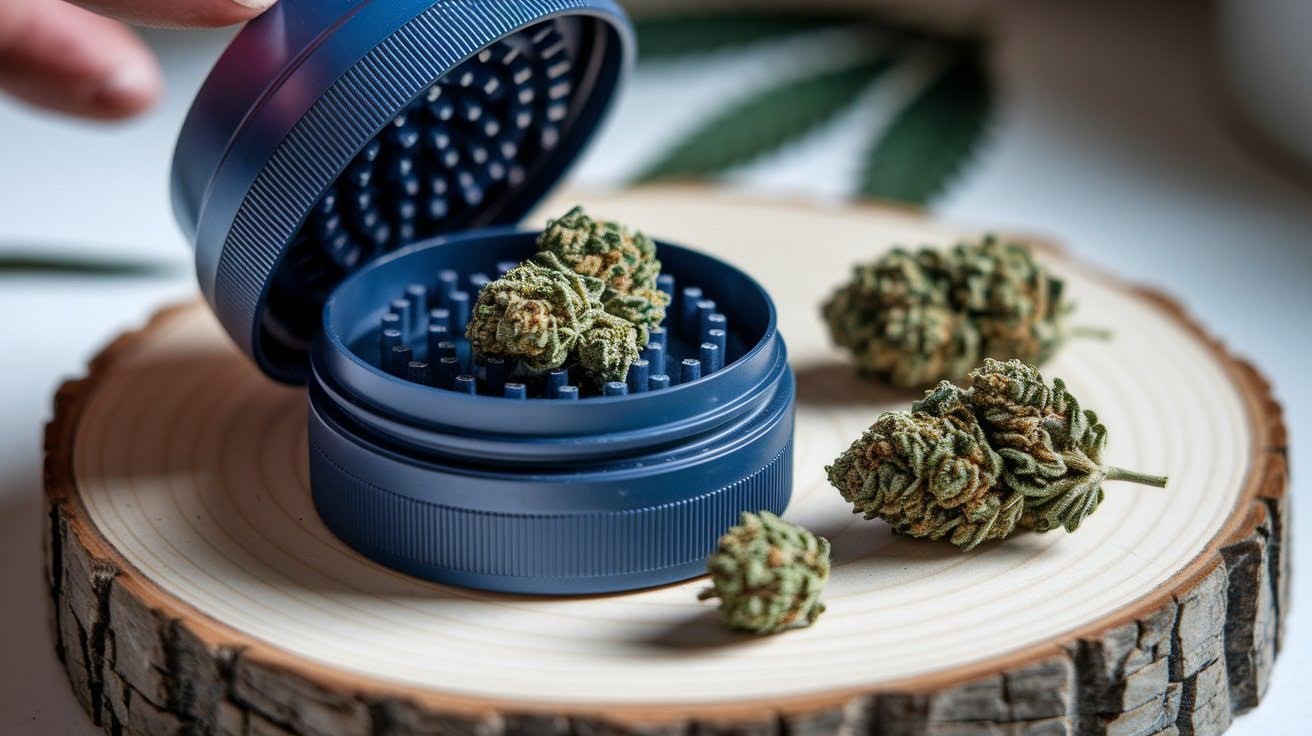
Loading your grinder correctly makes all the difference. Most people mess this up and wonder why their results suck.
Remove the grinder lid to access the main chamber. Place your broken-down buds between the grinding teeth, not just anywhere.
Distribute the herb evenly across the tooth surface. Think of it like spreading butter on toast – even coverage works better.
Here’s a crucial mistake to avoid: never place anything in the center pivot area. That central spot won’t get ground because of the magnetic pivot mechanism.
Now here’s the big rule – fill the grinding chamber only halfway. I know it’s tempting to stuff more in there, but resist.
Overloading makes twisting difficult and painful. Your hand will cramp up fast. Insufficient space results in uneven grinding that leaves chunks mixed with powder.
Allow room for your buds to move during processing. They need space to tumble around and hit those teeth properly.
Less is more when loading your grinder. Better to grind twice than ruin one batch.
3. Grinding Process
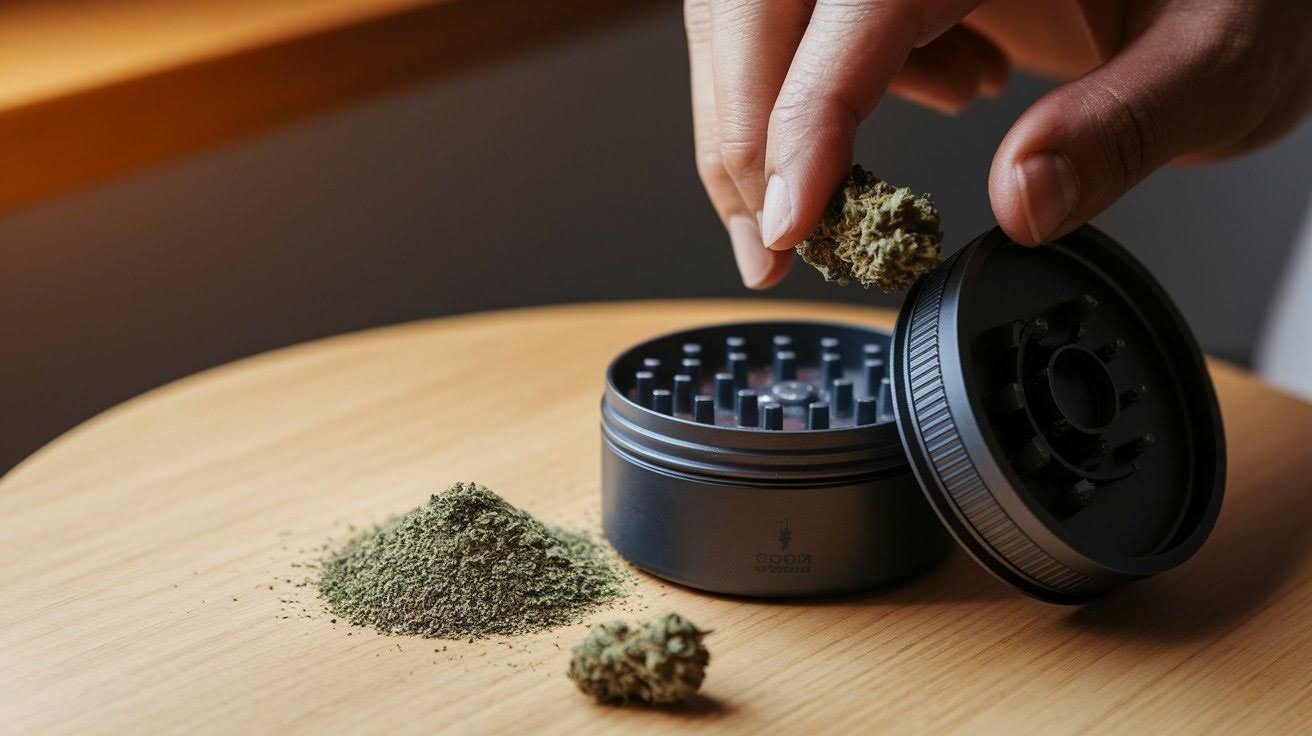
Now comes the fun part – actually grinding your weed. This is where technique matters most.
Replace the lid and press down tightly. Make sure it’s seated properly, or you’ll have a mess on your hands.
Hold the grinder with one hand on top and one on the bottom. Twist the halves in opposite directions like you’re opening a jar.
Apply gentle pressure while turning. You should feel slight resistance as the teeth break down your buds. Don’t force it too hard.
Give the lid 10-15 clockwise rotations to start. You’ll hear the grinding action working.
Continue until the resistance decreases – this usually takes 10-15 seconds total. The buds are breaking down properly when turning gets easier.
Here’s a pro tip: Twist in both directions to prevent sticking. Forward, then backward, then forward again.
Tap the sides and top during the grinding process. This ensures everything gets properly processed and nothing sticks to the walls.
Multiple grinding sessions may be needed for fine consistency. Don’t expect perfection on the first try.
4. Collection and Storage

Time to collect your perfectly ground cannabis. This step requires some care to avoid wasteful spills.
Carefully unscrew the lid from your grinder. Be gentle here – ground cannabis can stick to the top or fall everywhere if you’re not careful.
Use your fingers or a small tool to scoop from the collection chamber. A guitar pick works great for this job. Load your ground weed directly into joints, pipes, or vaporizers.
Here’s something important: Ground cannabis dries out faster than whole buds. Way faster.
Use airtight containers for storage if you’re not using everything immediately. Glass jars work perfectly for this purpose.
Store everything in cool, dark places. Heat and light break down the good stuff quickly.
Proper storage maintains potency and flavor longer than leaving it exposed to air.
Essential Tips for Cannabis Grinder Users
- Clean your grinder every 10-15 uses with isopropyl alcohol to prevent sticky buildup
- Place the grinder in the freezer for 15 minutes before cleaning to make the residue brittle and easier to remove
- Drop a clean coin in the chamber and shake vigorously to break down material and collect more kief
- Let cannabis dry for 30 minutes before grinding for better consistency
- Change grinding direction every few rotations to prevent material from sticking
- Store the grinder in the freezer briefly before use to make trichomes fall through the screen more easily
- Use guitar picks or pollen scrapers to collect kief without damaging grinder surfaces
- Never overload the grinding chamber – fill only halfway for even processing
- Replace worn kief screens when they become too clogged to function properly
Conclusion
Learning how to use a weed grinder properly makes all the difference in your smoking experience.
From choosing the right type to mastering the grinding technique, you now have everything needed for consistently perfect results.
Remember the basics: clean your grinder first, prep your buds by removing stems, load halfway, and grind with gentle pressure. Proper storage keeps your ground herb fresh longer.
With these techniques, you’ll get even burns, smoother hits, and maximum flavor from every session. No more uneven chunks or wasted weed.
Your grinder is now working for you, not against you. Start practicing these steps and see the difference for yourself.
Have questions about your specific grinder type? Drop a comment below and share your experience with fellow smokers.
Frequently Asked Questions
How do I clean my weed grinder before first use?
Wash all pieces with warm, soapy water and scrub with a soft brush. Rinse thoroughly and dry completely. This removes manufacturing residue and debris that could affect taste or performance.
How much weed should I put in my grinder?
Fill the grinding chamber only halfway. Overloading makes twisting difficult and creates uneven results. Break buds into smaller pieces first and avoid placing anything in the center pivot area.
How long should I grind my weed?
Grind for 10-15 seconds or until resistance decreases. Give 10-15 clockwise rotations, then twist in both directions to prevent sticking. Tap sides during grinding for even processing.
How do I store ground weed to keep it fresh?
Use airtight containers like glass jars and store them in cool, dark places. Ground cannabis dries faster than whole buds, so proper storage maintains potency and flavor longer.
What’s the difference between 2-piece and 4-piece grinders?
2-piece grinders are basic and affordable but lack collection chambers. 4-piece grinders have separate chambers for collection and kief catching, making them more functional for regular users.

